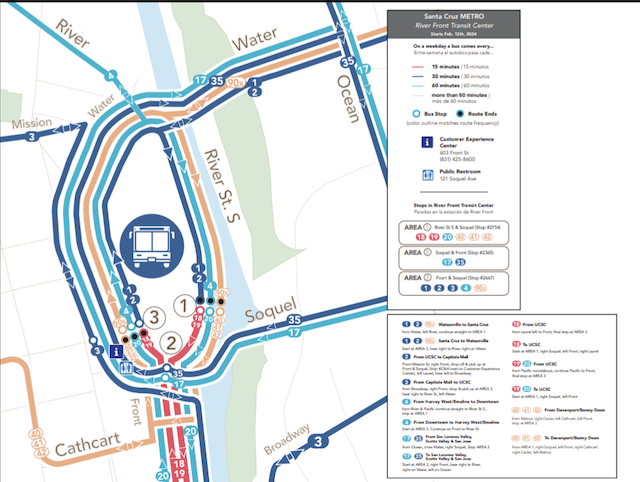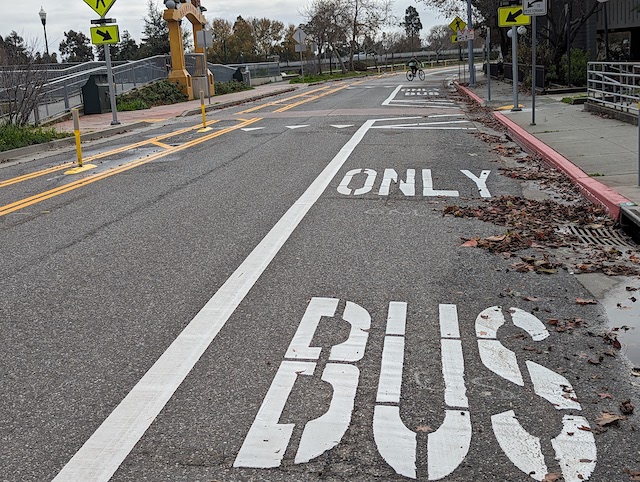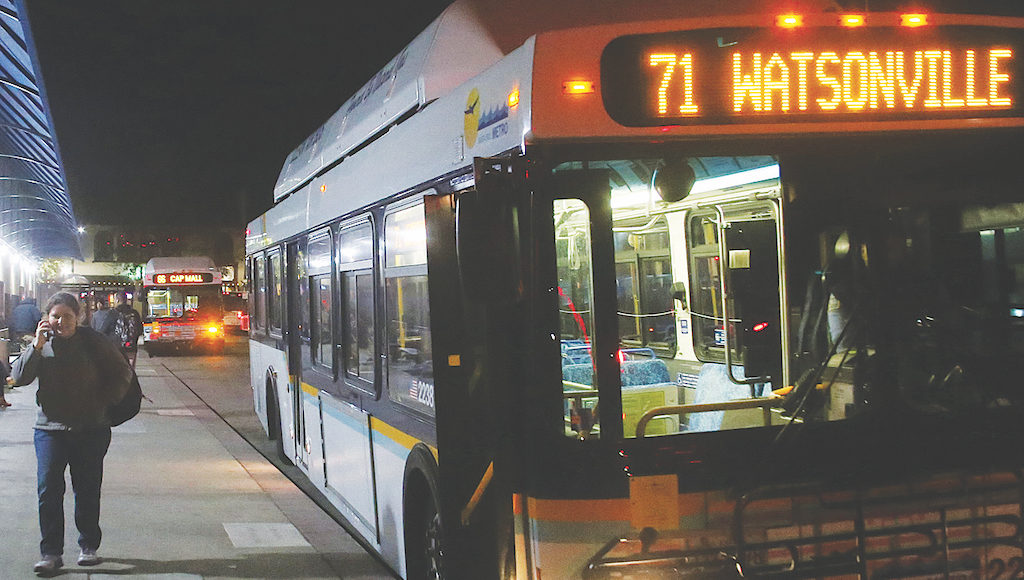The Santa Cruz Metropolitan Transit District’s (METRO) Pacific Station will close this week for a long-planned demolition and redevelopment. The METRO’s operations will move to a temporary transit hub a block away near the downtown CVS pharmacy.
The River Front Transit Center, as the new bus hub is called, will use the curbs on Soquel Ave., Front St, River St. and River St. South. Three new bus stops, deemed Areas 1, 2 and 3, will be added to serve as layover spots for buses.
The transition to the center will begin on Thursday, when METRO’s customer service/ticket sales booth at the Pacific Station will close. The lobby and restrooms will remain open until Feb. 11.
The new station will open Feb 12, including the customer service/ticket booth across the street at 603 Front St. To cushion the transition, METRO is offering free rides from Feb. 8 -25.
The METRO’s Pacific Station is slated to be revamped into Pacific Station North, a mixed-use complex with 126 units of affordable housing that will also include commercial and office space in addition to transit services. It should be finished in February 2026.
METRO chairperson Shebreh Kalantari-Johnson said in a statement that the new setup will be a big change for bus riders and motorists.
“We understand that the temporary closure and relocation of transit operations from Pacific Center to River Front Transit Center is a major adjustment for both METRO customers and motorists in downtown Santa Cruz,” said Shebreh Kalantari-Johnson. “We are working closely with our riders and the City of Santa Cruz to make this transition as smooth as possible.”
The River Front Transit Center will be organized like this:
Area 1: Located at the River St. South/Soquel Ave. intersection. Routes Served: 18, 19, 20, 40, 41, 42
Area 2 : Located at the existing stop on Soquel Ave. between River Street South and Front Street Routes Served: 17, 35
Area 3: Located at the existing Front Street stop alongside CVS Pharmacy. Routes Served: 1, 2, 3, 4, 90X

The new METRO location is already modifying the traffic flow. Within the last week, River Street South was made into a one-way going south to accommodate new bus lanes. Some confused drivers still turned north onto River Street South, continuing along as they would before the change, as this reporter noted. Additionally, on-street parking for Front Street and River Street South will be significantly reduced.
“Not only will the redevelopment of Pacific Station provide much-needed affordable housing, but it will help revitalize downtown Santa Cruz and reduce our region’s carbon emissions,” said METRO vice chair Kristen Brown.
Some local businesses are hopeful for the increased foot traffic the transit hub will bring.
“I’m excited for more business,” said Vanessa Brooks, a manager at the downtown CVS location.

More Changes
The uprooting of the METRO transit hub is the latest change in the recent shake-up in services. Last December, bus routes were overhauled as part of the Reimagine METRO initiative.
Routes 71, 69 (with its A, W and N variations), 68 and 66 were scrapped. In their place, routes 1, 2 and 3 (A and B) were created.
Routes 1 and 2 primarily link North and South County, and the route connects UC Santa Cruz to downtown and the Capitola Mall. Before the change, UCSC students would have to take two buses to get to the Capitola/Live Oak area.
METRO touted the new system as providing more frequent service between Watsonville and Santa Cruz, with a bus going in either direction leaving transit hubs every 15 minutes. But some bus riders found the new routes hard to navigate.
Brenda Garcia uses METRO as her main source of transportation to travel from her home in Capitola to all parts of the county. She said that the new system has actually reduced service.
“‘Reimagining‘ implies that you’re doing something radical and that you’re, you know, improving the lives of people. But in reality, they just cut lines. And so they cut lines and they’ve made it much more difficult to get around,” Garcia said.
Beatriz Hernandez lives near Pasatiempo Golf Course and takes the route 35 bus most days to get to work and back. She said that the route changes did not affect her and that her service remained the same. Hernandez was aware of the December route overhaul, and said she encountered METRO staff at bus stops informing riders of the new routes. She doesn’t think the recent shifts are all bad.
“One has to get used to and adapt to what they’re [METRO] doing. I guess they know what they’re doing,” Hernandez said.














The buses are running less frequently particularly the former 69. The three A and B are frequently late. Ideally busy should be leaving on time from the Metro center and not coming from somewhere else into the bus station. I am off in late due to the lengthy 3a and b. The 55 rarely runs and I have forgot that it ever existed. Although it takes more time I frequently walk due to the inadequacy of the bus system. The prior system was vastly superior. If the goal is to get people out of their cars and into the buses, this is a colossal failure.
Thanks for the information and I’m glad to be here under all of the new changes and improvements